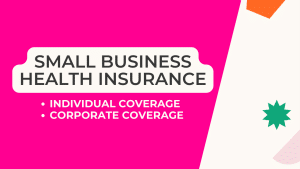First year as a small business owner? Or maybe the first year you’ve wanted to hire people who are asking if you offer health insurance?
I’m not going to sugar coat it: offering health insurance and benefits as a small business owner is complex. But you need it, too, so it’s worth researching the options on the individual and small business markets.
Although one of the first tips below is NOT TO RUSH THIS PROCESS, here’s a quick take on the longer article.
TL;DR:
-
-
- You as a business owner need health insurance as part of your compensation
- Although not required if under 50 W-2 employees, health benefits help you compete for talent
- Before you start, evaluate your budget and HR needs
- Know what co-pays, deductibles and co-insurance mean before you sign up
-
-
-
- Ask whether non-exchange plans are ACA-compliant
- Communicate your plans to employees by October 31
- Allow lots of time to review and compare plans – healthcare.gov is open until January 15 for individuals; companies should complete open enrollment by December 7
-
INDIVIDUAL OPTIONS
First year being self-employed? Welcome to the jungle. I hope you have a spare Tesla payment lying around. Accept healthcare as a cost of doing business and bake it into your prices.
If you’re trying to cover yourself or your immediate family and have no W-2 employees, your options are to buy from an exchange (Healthcare.gov or one of 18 state exchanges), or purchase a plan directly from an insurance company or broker.
Exchanges: It makes sense to start here as you may qualify for a subsidy, cost sharing reductions, or even Medicare under newly expanded state rules. You’ll need to know your AGI (adjusted gross income) and estimated earnings to calculate your subsidy eligibility.
How it works: Exchanges offer ACA-compliant medical, dental, and vision programs. Your base premium includes well child visits, annual exams, emergency care, and pregnancy. Providers cannot ask whether you have pre-existing conditions. Cost is based solely on your age.
Healthcare.gov’s open enrollment runs November 1 – January 15. State-specific exchanges may end as early as December 17 and as late as January 31. Make sure you know your marketplace and deadlines.
Direct market: Many insurance companies still allow you to purchase plans directly from them. Brokers can survey the marketplace and bring you direct purchase options.
How it works: Visit the website of the specific insurance company you want to use. Look for “individual and family” coverage options. Kaiser devotees, you can buy direct here. If you’re working with a broker, provide your preferred parameters and brands and see what options they deliver.
Note that direct purchase plans may not be ACA-compliant. If it matters to you, ask. If you’re not planning to get pregnant / are a cis man and don’t have pre-existing conditions — and I’m talking you’ve never had a sinus infection — you can roll the dice and save some money.
Overall, keep in mind that your company can pay your health insurance premiums — including your family’s if you’re the primary on the policy — as a tax-deductible expense. Simply set up the recurring payment to your company bank account or credit card.
CORPORATE SMALL GROUP OPTIONS
If you have fewer than 50 employees, you’re not required to offer a corporate health insurance plan. But, there are a few reasons you might want one.
Corporate plans typically include more perks than individual plans at the same price. If you’d like to access corporate insurance plans, you must have at least one W-2 employee who will enroll. If that’s not the case, go back up to individual options.
Note, if you will be offering corporate benefits, tell your employees by October 31. It’s a huge pain to un-enroll from an exchange or individual plan. They do not give the first month’s premium back.
You have three ways to offer corporate benefits: QSEHRA, company-sponsored plan, or PEO.
QSEHRA: If you’re not quite ready to provide a full slate of corporate insurance programs, using a QSEHRA reimbursement is a great option for providing benefits without actually providing benefits. Pronounced cue-SARAH, this an IRS-approved program in which you reimburse your employees and you each get a tax benefit.
How it works: You choose the reimbursement amount, up to up to $440 per month for an individual or $880 per month with dependents. Your employees choose their own medical plans from an exchange, direct, or their previous employer’s COBRA and make the monthly payments. They provide you with a bill and you set up a recurring payroll reimbursement. Learn more here.
Company-sponsored plan: Through an exchange, direct buy, or insurance broker, you can choose an ACA-compliant plan for yourself and your team. Check out sample SHOP plans from Healthcare.gov .
How it works: You must pay 50% of the employee’s base premium, typically $300-$400 per month, based on their age. However, you can pay more at your discretion, and offer to cover or subsidize dependents. Depending on your industry or local market, you may need to offer a higher level of coverage to be competitive in hiring.
Plan levels are coded by metals. Bronze has the lowest monthly cost but has high deductibles, co-pays, and out of pocket maximums. Silver and Gold have lower deductibles and co-pays, and Platinum is old school “Cadillac” coverage with no deductibles or co-pays.
If you’re working with a broker or insurance company, you may be able to offer enhancements like behavioral health or coverage for fertility treatments. They may also allow a buy-up at the employee’s discretion to a higher-level plan from the same insurance provider.
Note that if you qualify with, say, one W-2 employee and that person subsequently takes another job, you get to keep the corporate plan for the rest of the calendar year.
PEO: PEO stands for “professional employer organization.” It’s basically a company that can act as your HR department and bundle groups of employees together for insurance buying power. If you want to offer multiple plans or compete with the Fortune 500 (and get their scale discounts), a PEO is typically the best option. Most will charge a flat rate per person versus age-based pricing. And they may include perks like concierge medical, no-cost telemedicine, and fertility treatment coverage.
How it works: A PEO acts as a “co-employer” with some rights over the policies and procedures used to manage your team. To access PEO health insurance, you’ll need to sign up for their payroll and compliance services and pay a monthly fee per employee, in addition to at least 50% of base level health insurance premiums.
If you’d like to start your benefits on January 1, 2022, you should choose a PEO as soon as possible in October so you can get your account set up in time for open enrollment before December 7. Learn more.
In conclusion: yes, this sucks
Until we have a state or federal public option, these are the choices. They are expensive, they are convoluted, and yes, you will still have to fight with your damn insurance company when, say, their directory is not current and they tell you they cover a doctor that that recently moved out of network or they just simply don’t want to pay for stuff and are hoping you’re not willing to fight with them over the phone for, say, 2 years of your life.
(Those are real examples from my entrepreneurial life. First example is United Healthcare from this year when I triple-checked my primary care doc was in our shitty Bronze network and then four months later when I actually had the appointment, she wasn’t. Second is Delta Dental, still refusing to issue three reimbursement checks from 2019 and crying HIPAA when I call the Better Business Bureau. I do not recommend them.)
For now, it’s the system we’ve got. (#vote2022) May the odds be ever in your favor.
PS – If you’d like to explore what you can afford or want to structure your business so you can offer great benefits, let’s work on your strategic plan. Grab a free 30-minute Strategy Session with me this week.



